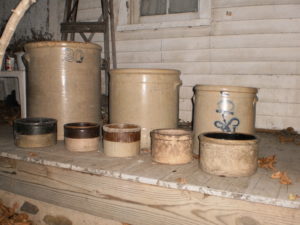
Go back in time 100+ years and stoneware crocks were a mainstay in kitchens all over the world. They played a big role in keeping food fresh before the introduction of refrigerators.
While stoneware crocks could still be useful in today’s day and age, they’re not nearly as functional as they once were. After all, almost every home has at least one refrigerator.
However, antique stoneware crocks are loved by millions of collectors.
If you’re starting your antique stoneware crock collection or looking to add a few more pieces, it’s time that you learn how to identify the age. After all, this goes a long way in helping decipher the origins and value.
Here are some things you need to know:
• American potters began using salt glaze on crocks after 1775
• Crocks with pattern names on the bottom were made after 1810
• Any crock with the word Ltd. or limited was made after 1861
• Any crock that says “made in” was generally made in the 1900s
• If there’s a sticker on top of the glaze, it was likely made in the late 1800s (or after)
Many stoneware crocks were imported to the United States from Europe during the late 1700s. At the same time, American potters began making these pieces in the early 1700s, primarily in Pennsylvania, New Jersey, and New York.
Knowing how to identify the age of antique stoneware crocks makes it much easier to value a piece and decide if it’s a good addition to your collection
Four Sales is the leading estate sale company in Virginia, DC and Maryland. For the past 40+ years, Four Sales has conducted over 3,000 estate sales in Virginia, DC and Maryland. Four Sales estate sales headquarters is in Alexandria, Virginia with regional offices in Charlottesville, Virginia and Annapolis, Maryland.
